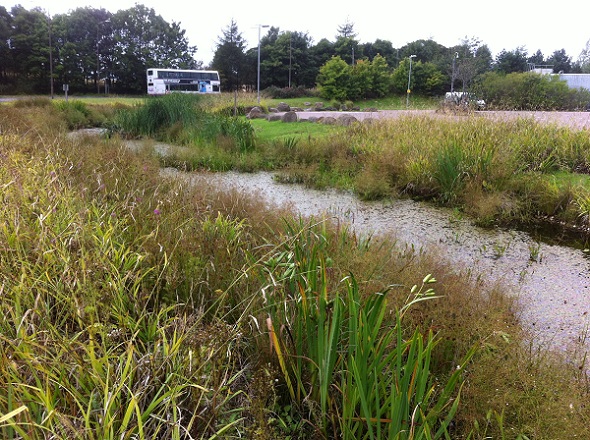
September 18, 2018, by Blue-Green team
SUDSnet International conference and network
In this blog Vladimir Krivtsov shares his very positive impressions of the recent SUDSnet conference, which he had the pleasure to attend at the end of August 2018. It took place at Coventry University, and was dedicated to the celebration of 15 years of SUDSnet’s existence.
SUDSnet is a UK-wide network for researchers, practitioners, agencies, developers and all those who are interested in Sustainable Drainage Systems (SuDS)
Both days of the conference started with very interesting key note talks, and there was plenty of time for networking over the refreshment breaks, as well as during the conference dinner.
There were talks and posters covering a range of topics, including; logistics of operating SuDS infrastructure in challenging environments; water quality and pollution control; multiple benefits of SuDS in relation to biodiversity and wildlife habitats; the choice of plants and planters for source control assets; hydrological monitoring of SuDS performance; permeable filters and filter media; Natural Flood Management and Rural SuDS; education and raising awareness of SuDS, and; stakeholder engagement (see the conference programme for further details). The geographical coverage was impressively widespread (e.g. Iraq, South Africa, EU), and there was even a special session devoted to the international case studies.

Figure 1. Awareness of General Binding Rules (GBR) regulating pollution prevention and ownership of the premises.
Retrofit SuDS
A number of presentations discussed issues related to SuDS retrofits. For example, the logistics of retrofitting SuDS were discussed in the talks related to international case studies, including the challenging conditions of refugee camps. At a more local level there were presentations dealing with installations of SuDS on Scottish farms and industrial estates. According to the current legislation, all new developments in Scotland must have SuDS. The developers appear to be aware of that, but often go for installation of a limited number of features (e.g. permeable pavements in industrial estates; permeable pavements and/or swales and basins in housing estates) largely ignoring other possibilities.
It was reported that the majority of industry representatives have difficulties with terminology. Furthermore, about 75% of companies do not know about the General Binding Rules regulating pollution prevention and SuDS installation (Figure 1). There is a lot of confusion with understanding SuDS purpose, benefits and technology. There are also issues with maintenance, hence considerable scope for improvement! Figures 2 and 3 suggest some examples of specific SuDS features suitable for retrofitting into public roads and industrial premises respectively. These examples are from a study conducted by the Heriot-Watt team at Houston Industrial Estate (West Lothian, Scotland), but the results are expected to be applicable elsewhere in Britain and further afield.

Figure 3. SuDS Retrofit options for industrial premises at Houston Industrial Estate (West Lothian, Scotland).
Summary
All in all, the conference turned out to be very relevant to the Urban Flood Resilence project. I think that SUDSnet appears to be a very vibrant and worthwhile network. Their conferences take place every 3 years, and I will certainly be trying my best to attend the next one (alas subject to funding). The presentations from the recent one are due to appear online (keep checking SUDSnet 2018 presentations) – all great stuff, cannot recommend it more. I hope you will enjoy them as much as I did!
Vladimir Krivtsov wrote this blog with contributions from the Heriot-Watt team (Scott Arthur and Brian D’Arcy). Read more about their work on the Urban Flood Resilience project in WP1. Resilience and WP2. Resource.
No comments yet, fill out a comment to be the first


Leave a Reply